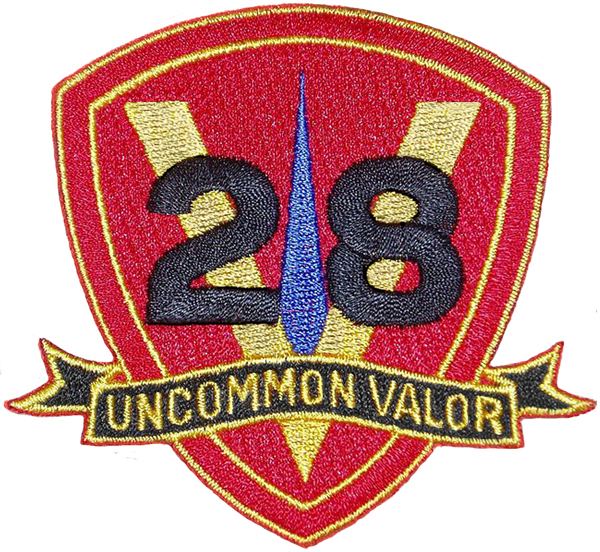Active 1944–1946 Type Infantry | Country United States Size 3,250 | |
 | ||
Branch | ||
The 28th Marine Regiment (28th Marines) is an infantry regiment of the United States Marine Corps. The regiment (inactive since the Vietnam War) which is part of the 5th Marine Division, fought in the Battle of Iwo Jima during World War II. Six Marines of the 2nd Battalion, 28th Marines were featured in the historical photo by Joe Rosenthal of the U.S. flag raising on top of Mount Suribachi.
Contents
Subordinate units
The regiment comprised three infantry battalions and one headquarters battalion:
Formation and preparation for combat
The 28th Marine Regiment was activated on 8 February 1944 at Marine Corps Base Camp Pendleton, California. Many of the first members of the regiment had previously been members of the recently disbanded Raiders and Paramarines. The regiment was initially staged at Tent Camp 1 in the Las Pulgas Valley on Camp Pendleton. Upon completion of their training in late September to early October they boarded troop ships in San Diego, California and sailed to Hilo, Hawaii where they would eventually call Camp Tarawa home. They remained there for the next four months training for their first mission.
The 28th Marines was originally scheduled to assault Yap in the Caroline Islands in the fall of 1944 but a change in strategy at higher levels would allow for a few more months of training and planning for the next mission. On 19 October 1944, Colonel Liversedge received tentative plans for the invasion of Iwo Jima and would set in place two more months of intensive training preparing his men for the amphibious assault upon the volcanic island. The plan created by the efforts of the V Amphibious Corps in November and December 1944 called for the 28th Marines to land at Green Beach which was on the far left of the landing zone, just at the base of Mount Suribachi. The 1st and 2nd Battalions, 28th Marines were to drive across the 750 yard neck of the island and cut off the mountain from the rest of the island. The 3rd Battalion, 28th Marines was placed in reserve for the initial assault.
The 28th Marines embarked upon amphibious transports in late December and after a few days liberty in Pearl Harbor they set sail heading west on 7 January 1945. The regiment stopped at Eniwetok on 5 February, conducted a practice landing on Tinian on 13 February and arrived off the coast of Iwo Jima on 16 February.
Iwo Jima
The first portions of the 28th Marines landed on Iwo Jima at Green Beach just after 0900 on 19 February 1945. The 1st and 2nd Battalion, 28th Marines were first ashore and within 90 minutes of hitting the beach small units from these battalions had reached the west coast of the island. The 3rd Battalion, 28th Marines was fully ashore by 1300 that afternoon, having taken heavy casualties in the water and while crossing the beach. By late in the afternoon the regiment had isolated Mount Suribachi and began to commence its attacks south against the defenders of the island redoubt. The 28th Marines were the only of the four regiments that landed on D-Day to achieve their objectives.
From 19 to 23 February, the 28th Marines fought to secure Mount Suribachi. Progress was initially slow and measured in yards as they had to fight their way through hundreds of layered and mutually supporting Japanese pillboxes, blockhouses, spiderholes, and strongpoints. By the morning of 23 February, Suribachi had been encircled. Col. Liversledge called for a reconnaissance patrol to scale the mountain a find a path to the top if possible. Chosen for the mission was the 3rd Platoon, Easy Company, 2nd Battalion, 28th Marines. These men reached the summit at approximately 1020 and proceeded to raise a U.S. flag. It was the raising of this flag that led the then Secretary of the Navy, James Forrestal, to comment that "...the raising of that flag on Suribachi means a Marine Corps for the next five hundred years". Fearing that the flag would be taken by higher-ups, Lt. Col. Chandler Johnson, commander of the 2nd Battalion, 28th Marines, ordered a second patrol to the top of the mountain to replace the flag with a larger one that could later be given to any senior ranking personnel that wanted it as he intended for the first flag to remain with the battalion. It was the raising of this second flag that was caught on film by Joe Rosenthal and would become the iconic photo of the battle.
Post–Iwo Jima and inactivation
After the Battle of Iwo Jima, the 28th Marines, 5th Marine Division sailed back to Hawaii and Camp Tarawa where they began to refit for the planned invasion of Japan. They were tasked with being part of Operation Olympic, the planned invasion of Kyushu. Upon the Japanese surrender they sailed for mainland Japan where they landed at the port of Sasebo on 22 September 1945, becoming part of the American occupation force. Three months later they set sail again this time for Marine Corps Base Camp Pendleton, California. The 28th Marines was inactivated on 23 January 1946 as part of the post-war drawdown of forces.
